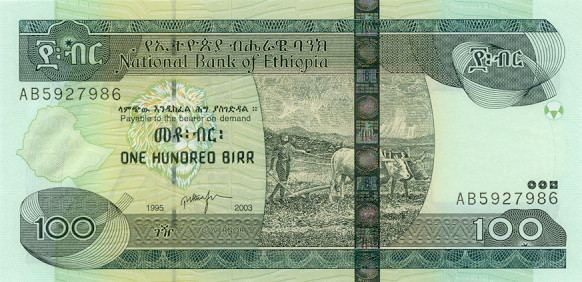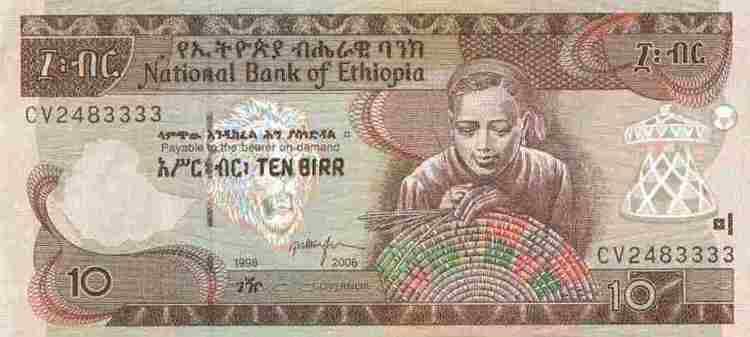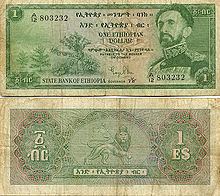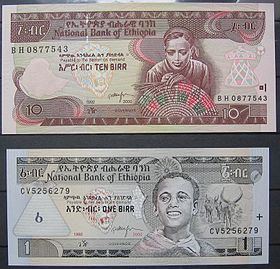Code ETB Banknotes 1, 5, 10, 50, 100 birr | 1/100 santim | |
 | ||
Symbol Br (Latin Script)ብር (Ethiopic Script) Coins 1, 5, 10, 25, 50 santim; 1 Birr | ||
All banknotes of ethiopian birr 1 birr to 100 birr 1997 to 2013 issue in hd
The birr (Amharic: ብር?) is the unit of currency in Ethiopia. Before 1976, dollar was the official English translation of birr. Today, it is officially birr in English as well.
Contents
- All banknotes of ethiopian birr 1 birr to 100 birr 1997 to 2013 issue in hd
- Currency special part 7 ethiopian birr thiopischer birr
- First birr 18551936
- Italian lira 193641
- East African shilling 194145
- Second birr 1945
- First birr
- Second birr
- Identification and appearance
- References

In 1931, the Emperor of Ethiopia, Haile Selassie I, formally requested that the international community use the name Ethiopia (as it had already been known internally for at least 1600 years) instead of Abyssinia, and the issuing Bank of Abyssinia also became the Bank of Ethiopia. Thus, the pre-1931 currency could be considered the Abyssinian birr and the post-1931 currency the Ethiopian birr, although it was the same country and the same currency before and after.

186 billion birr were in circulation in 2008 ($14.7 billion or €9.97 billion).
Currency special part 7 ethiopian birr thiopischer birr
First birr, 1855–1936
In the 18th and 19th centuries, Maria Theresa thalers and blocks of salt called "amole tchew" (አሞሌ ) served as currency in Ethiopia. The thaler was known locally as the Birr (literally meaning "silver" in Ge'ez and Amharic) or ታላሪ taleri. The Maria Theresa thaler was officially adopted as the standard coin in 1855, although the Indian rupee and the Mexican dollar were also used in foreign trade.

The talari (thaler, dollar, birr) became the standard unit on 9 February 1893 and 200,000 dollars were produced at the Paris Mint in 1894 for Menelik II. The talari, equivalent to the Maria Theresa thaler, was divided into 20 ghersh (also guerche or gersh, the name coming from the Ottoman Empire's qirsh) or 40 bessa (a small copper coin).

A new Ethiopian coinage appeared about 1903. The new silver birr maintained the same weight and fineness as the old, but there was now a quarter-birr and a silver ghersh, the latter 1/16 the weight of the birr. The money of account now became 1 birr' = 16 ghersh = 32 bessa.

The Bank of Abyssinia was established in 1905 by Emperor Menelik and the European banking group behind the National Bank of Egypt; the bank was officially inaugurated by Menelik on 15 February 1906. The Ethiopian coinage gained acceptance only gradually, and Bank of Abyssinia imported Maria Theresa thalers. By the time World War One broke out, the bank was still importing about 1,200,000 of these coins annually. Bank of Abyssinia put banknotes into circulation in 1915. These notes were denominated birr in Amharic and thaler in English. They were used by merchants and by foreigners but were not initially accepted generally. However, Note circulation increased considerably after 1925.
Emperor Haile Selassie bought out the Bank of Abyssinia in 1931 for £235,000 in order to make it a purely Ethiopian institution. It was reorganized as Bank of Ethiopia. At the same time, the currency was decimalized and token nickel and copper coins were introduced, the birr becoming equal to 100 metonnyas (often written matonas). The text on the bank's notes appeared in Amharic and French.
By the mid-1930s circulation consisted chiefly of Maria Theresa and Menelik talari.
Italian lira, 1936–41
Not long after the Italian occupation and the transformation of Ethiopia into Italian East Africa, the Italian lira was introduced (15 July 1936) and Ethiopian banknotes were withdrawn from circulation at 3 lire per talar (birr). In an effort to increase the use of Italian paper money, the exchange rate for silver coin (Maria Theresa thalers) was raised to 4.50 lire, then to 5.00, and eventually, in stages, to 13.50. Still, many people kept their Ethiopian coins and banknotes.
Regular Italian coins and banknotes of Banca d'Italia circulated after 15 July 1936. Special notes with a red overprint were authorized for Italian East Africa on 12 September 1938, and a large quantity was printed. It is not clear, however, when, where, and to what extent these special notes actually circulated.
East African shilling, 1941–45
During the East African Campaign of 1941, British forces brought with them Indian, Egyptian, British, and British East African currency, and all were received in official payments. Italian coins and notes of up to 50 lire were allowed to continue in circulation to serve as small change; higher denominations were withdrawn at a rate of 24 lire per shilling. Maria Theresa thalers were allowed to circulate with a value of 1s 10½d (or 45 lire). The East African shilling became the money of account on 1 July 1942; it eventually became the sole legal tender and remained so until 1945.
Regular notes of the East African Currency Board were used for circulation in Ethiopia.
Second birr, 1945–
The birr was reintroduced in 1945 at a rate of 1 birr = 2 shillings. The name Ethiopian dollar was used in the English text on the banknotes. It was divided into 100 santim (derived from the French centime). The name birr became the official name, used in all languages, in 1976.
First birr
Between 1894 and 1897 copper coins were introduced in denominations of 1⁄100 and 1⁄32 birr, together with silver 1 ghersh, 1⁄8, 1⁄4, 1⁄2 and 1 birr, and gold 1⁄4, 1⁄2 and 1 werk. In 1931, a new series of coins was introduced consisting of copper 1 and 5 metonnyas, and nickel 10, 20 and 50 metonnyas.
Second birr
In 1944 (EE1936 in the Ethiopian calendar), coins were reintroduced, with copper 1, 5, 10 and 25 santim and silver 50 santim. A second series was issued in 1977 (EE1969). It consisted of aluminium 1 santim, brass 5 and 10 santim, and cupro-nickel 25 and 50 santim. The most recent issues are:
The dates, like the rest of the legend, appear in Amharic, the official language of Ethiopia.
Identification and appearance
Besides having almost all the legends in Amharic, there are two features that help to immediately identify an Ethiopian birr. Early dated coins, those dated before EE1969, feature a crowned rampant lion holding a cross. This can be seen in the adjacent picture. Later dated coins, those dated EE1969 or after, picture the head of a roaring lion, with a flowing mane.
Coins were struck at several mints, including Paris, Berlin, and Addis Ababa. Coins without mintmarks were generally struck at Addis Ababa. The coins struck at Paris have either the mintmark "A" with the cornucopia and fasces privy marks, or the cornucopia and torch privy marks without the "A".
